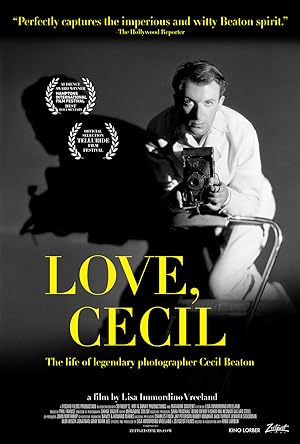Love, Cecil is a documentary about Cecil Beaton, an aesthete who was well known for his work as a fashion, portrait and war photographer, illustrator, diarist, and stage and costume designer for movies and theater. I actually knew very little about him, but became interested in the documentary when I repeatedly saw the trailer. It only lasted at the movie theater for a week, and on its last day, it was reduced to two daytime showings; thus further reducing the likelihood that anyone who is working will see it if they didn’t prioritize seeing it on the weekend.
Love, Cecil has to be good because I went to a 9:25 pm showing on a Wednesday night and without the aid of caffeine, even though I was in a very comfortable reclining chair, did not fall asleep. It is a beautiful, dynamic film that brings Beaton’s encyclopedic work to life for the big screen and immerses us in the feel of Beaton’s adult daily life from 1920s through 1980. Director Lisa Immordino Vreeland artfully inserts his home videos adjacent to his still photographs in a cinematic photo album interspersed with talking heads reflecting on Beaton’s significance in the broader cultural landscape.
Narrated by my all time favorite, Rupert Everett, whose voice is as attractive as the man, Love, Cecil takes us on a mostly chronological journey of Beaton’s life from his humble middle class origins to high society. It is equal parts dishy and detailed about his ascent and the obstacles that he faced due to the chasm of class and self-sabotage. While he may not be the first of his kind, he was definitely the most memorable.
The people who marketed Love, Cecil wisely omitted referencing one of those obstacles in the previews—his casual and completely extraneous use of a problematic racial epithet in one of his illustrations for a notable Manhattan based magazine with Jewish employers during the time of Hitler’s growing political triumph in Germany. If I had known about it, I don’t care how bad he felt, I would not have been slightly interested in learning more about his journey to success particularly in light of my current outrage that no matter how egregiously some people behave, they never get cancelled, can plead youthful ignorance of what is considered bad behavior and prosper. Here is a public service announcement: don’t use racial epithets, don’t wear black face and don’t do or say anything that you would not want someone else to say about a group that you belong to, especially at work, but ideally in your personal life too. Is it really worth losing even a single paycheck to write one word that you never need to use, especially when it makes no sense given the context?
Love, Cecil shows that during World War II, Beaton’s work as a war photographer had echoes reminiscent of Tom of Finland in finding the erotic and beauty in unlikely arenas. We are fortunate to explicitly have Beaton’s reflections on his sexuality. Even though he considered himself gay, he did have a very serious relationship with one globally famous woman who was known as a lesbian, but early in the film, he reveals that he tried not to be gay. Instead of classifying Beaton as bisexual, which he does not do, it could be a one time event that results from a mix of the transcendent nature of their mutual admiration and uniqueness of these individuals (love is love) and an understandable desire to conform to society’s standards when that was a normal thing to do.
The only time that Love, Cecil slightly waivers in terms of a chronological story is when it addresses his family life, specifically his father and brother. It is the only time that the film backtracks slightly and hints at Beaton’s discomfort at not quite fitting into expected gender norms. Fortunately, he faced no similar difficulty in his relationship with the women in his life or his furry family, Timothy White, his cat, who for me, provides a level of redemption to him that I was unwilling to accept without a feline’s corroboration. Cats don’t need to like anyone so when they do, I’d like to believe that it means something.
Love, Cecil shows that Beaton was not just a fly by night success, but he continued to be on the cutting edge of culture as he got older instead of being like most of us or vampires, stuck in the era of our youth and less enraptured by the world around us. If there is a tragedy, it is that we do not benefit from his ability to frame and highlight the beauty in today’s world even in the midst of tragedy. He is praised for his iconic photo of a child victim during an air raid in 1940 and for noting the importance of the Rolling Stones during an accidental encounter. What could he have done with someone like Prince or today’s rampant victimization of the vulnerable if his eyes could continue to conquer his impulse to eat from the hate tree?
Love, Cecil left me feeling infected by Beaton’s zest for life. “Be daring. Be different. Be impractical.” As he got older, he was torn between feeling sadness over losing so much and gratitude for fitting so much into his limited time. There are valuable lessons to be taken away from Beaton’s anything but ordinary life even if you are like me, a person with a day job and a structured path and less like him who struck out on adventures with an unknown destination in uncharted territory. Both types can carve out an enthusiastic place of fullness with the people and things that we love.
Stay In The Know
Join my mailing list to get updates about recent reviews, upcoming speaking engagements, and film news.




